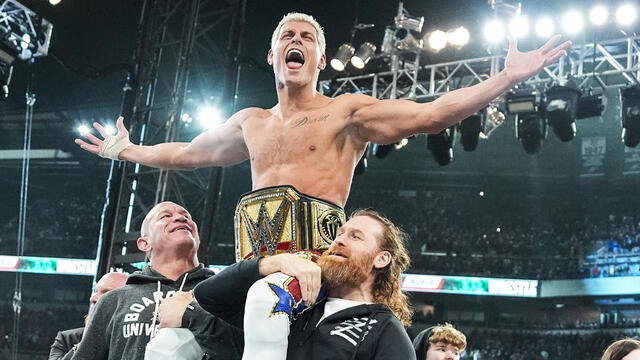
Forever young: The life and times of Johnnie Mae Young

Forget, for a moment, the Mae Young you know.
Don’t think of her at nearly 80 years of age, hair frazzled, legs in the air, inexplicably procreating a human hand. Instead, see her at 17, a teenage knockout with raven hair who might seem as innocent and alluring as a pinup girl if it wasn’t for that cigar in her teeth.
This is Mae Young in 1939 — the year “The Wizard of Oz” was first released and a gallon of gas cost a dime — on the day she came stomping into the Tulsa Coliseum with a challenge for the top female wrestler in the country.
Young may have been cupcake cute, but she was a tomboy — a rough one at that who kicked field goals for the boys’ football team and was not afraid to get into fistfights with grown men. Born in Sand Springs, Okla., on March 12, 1923, she was named Johnnie after a father she barely knew and raised, along with eight siblings, by a single mother during dire economic times.
One could imagine her childhood looking like a sepia-toned photograph of The Great Depression — all cropless fields and dust caked shanty towns — but her memories don’t allow for that.
Instead, she enjoyed her youth as both a brilliant athlete and a tenacious fighter. At school, she led Sand Springs High to a national title in softball. At home, she stood back and grinned as her brother lured unassuming neighborhood boys to their front yard, daring them to tangle with his kid sister. Young was 5-foot-7 and adult strong, and she had no trouble making hapless twerps cry uncle.
“I wrestled dirty and I was a tough son of a gun,” Young said in “Lipstick & Dynamite,” a 2004 documentary about the first ladies of wrestling.
When the famous women’s wrestling champion, Mildred Burke, came to the Tulsa Coliseum in 1939, Young had the confidence to go to the event and issue a challenge to the “Queen of the Mat.” Burke wasn’t just a national star — she was a powerhouse with bowling ball biceps and legs like a T-Rex. But Billy Wolfe, Burke’s husband, manager and the all-powerful impresario of female wrestling at the time, was unwilling to put his star up against this cocksure unknown. So he sent the top baddie in his stable after her — Gladys “Kill ’Em” Gillem.
“Kill ’Em” earned her nickname the hard way, but, as Mae tells it, Gillem went down within seconds.
With that, Young was immediately welcomed into Wolfe’s dysfunctional family of lady wrestlers. Leaving behind Sand Springs, Mae set about traversing the country by car, driving endless miles across faulty local roads in the days before GPS and interstate highways. Although she was only a teenager at the time, Young quickly became the troupe's big villain — easily surpassing “Kill ’Em” Gillem — and began battling Burke over the Women’s World Championship in front of thousands of fans across the country.
Young never won that title — not once in her career did she hold a major championship — but she didn’t need it. Ten pounds of title gold wouldn’t have enhanced Mae’s reputation as a woman who, as Freddie Blassie once put it, “could whip 60 percent of the men in the wrestling business in her prime.” Instead of allowing a title to define her, Young defined herself in the saloons where she swore and played poker and in the ring where she had taken to calling herself “The Great” Mae Young.
Sometimes sporting an audacious crown on her way down the aisle, the Okie embraced her role as a villain and savored making life very difficult for goody two shoes opponents like Ann LaVerne and June Byers. Years later, she would say how much she enjoyed it when audiences chucked eggs and rotten vegetables at her, how she loved to hear them boo.
Mae was wrestling in Memphis, Tenn., on Dec. 7, 1941, the day Pearl Harbor was bombed and the United States entered World War II. With many of the top male wrestlers now enlisted, women — along with, believe it or not, bears and midgets — became the top sports-entertainment attractions in the country and Young was at the forefront of the movement.
Alongside Mildred Burke, Young became the first female to wrestle professionally in Canada when she went up to Calgary, Alberta, to compete for WWE Hall of Famer Stu Hart. She also blazed into major cities like New York and Chicago where women’s wrestling had formerly been banned in the name of public decency.
The story of Young and company barnstorming wartime America with their traveling women’s wrestling show is an appealing one. You can almost picture Jennifer Lawrence playing cute in the lead role as a scrappy, but determined woman intent on proving that the gals could do it just as well as the fellas. But there was an underlying ugliness to all this manifest destiny.
For one, female wrestling was still viewed as more of a sideshow attraction than a legitimate display of athleticism by the general public. And Billy Wolfe, the mastermind behind the whole roadside circus, was fiendishly manipulative. The slick-haired huckster played the women against one another while keeping the bulk of the earnings for himself. When his oily behavior finally severed his relationship with Burke, the two began to vie for dominance over women’s wrestling behind the scenes. Through it all, Young just kept on swinging.
Mae Young found her partner in crime in the late 1940s when she began training a naïve hopeful from Tookiedoo, S.C., named Lillian Ellison. Mae gave the Southern belle an impolite introduction to the tough world of women’s wrestling, but Ellison caught on to the game better than anyone else. Soon, Lillian would change her name to The Fabulous Moolah and become the undefeated Women’s Champion for 29 years, the top promoter of female wrestlers and Young’s lifelong friend.
In the years before Moolah's 2007 passing, the pair lived on separate floors of Moolah’s estate in Columbia, S.C., along with a midget wrestler named Diamond Lil in a setup that would have made for history's most watchable reality show had anyone had the foresight to film it.
As women’s wrestling faded into kitsch during those postwar decades, Young seemed poised to carry out her days in this domestic obscurity. Sure, she trained a few decent wrestlers alongside Moolah, but who knew about her pivotal role in bringing female grappling to Japan less than a decade after the U.S. dropped the bomb? Who wrote about the unique revolution she spurred alongside Gladys “Kill ‘’Em” Gillem and Mildred Burke in America? How many sports-entertainment fans even knew the name Mae Young?
That changed in 1999 when Mae and Moolah reemerged in WWE as septuagenarians in smart slacks and lovely sweaters and raised hell. While most folks their age were lining up for an early dinner at the Golden Corral, the old friends were getting powerbombed through tables and shellacked by guitars.
It’s natural to think a mockery was being made of the great ladies wrestlers, but reinvention is the key to survival in sports-entertainment. As relics of a black-and-white era, the pair would have been politely applauded by raucous “Attitude Era” fans. But when they embraced the age as lewd, aggressive seniors, they became two of the most unexpected heroes of WWE’s biggest boom period, WWE Hall of Famers and the subjects of a wonderful 2004 documentary, “Lipstick and Dynamite,” that finally brought their careers to light.
Anyway, whoever mistook Young for a matronly grandmother should watch her 2005 appearance on “Late Night with Conan O’Brien.” During the course of a brief, eight-minute interview, the incorrigible Mae continually taunts the host by saying, “You wanna wrestle dirty with me?” before finally slapping him in the face with her bra pad. Yes, the Mae Young who mothered a dismembered hand and played tonsil hockey with Eric Bischoff is the Mae Young you know. But she may also very well be Mae Young.
“When it comes to who was the toughest woman, there are no debates,” WWE Hall of Famer Jim Ross wrote in a 2008 column. “Johnnie Mae Young is universally considered to be the baddest of the bad when it comes to women's wrestling.”
Young passed away on Jan. 14, 2014, at the age of 90. The sports-entertainment world mourned the loss of the last of an old guard, but took comfort in the knowledge that Mae left when she was ready. No one on Heaven or Earth would have had the guts to make her do otherwise.
WWE Shows Latest Results
Raw results, April 15, 2024: Chad Gable viciously attacks Sami Zayn after losing to Zayn in Intercontinental Title Match!
Full ResultsSmackDown results, April 12, 2024: LA Knight and AJ Styles earn victories for a chance to challenge Cody Rhodes at WWE Backlash!
Full ResultsWWE NXT results, April 16, 2024: Trick Williams defeats Carmelo Hayes in a Steel Cage Match
Full Results

















